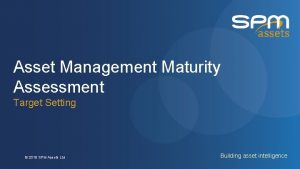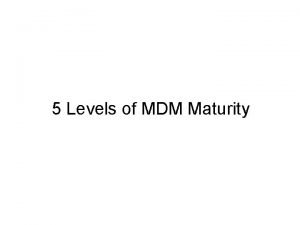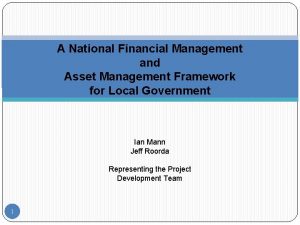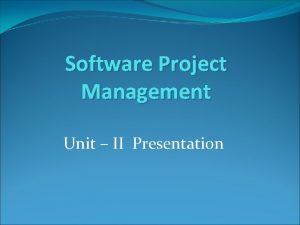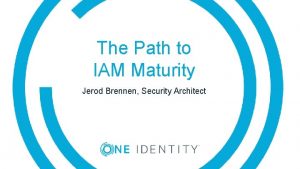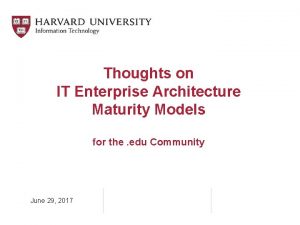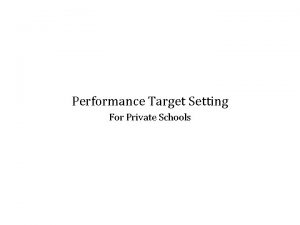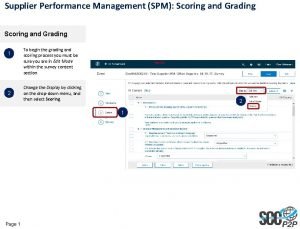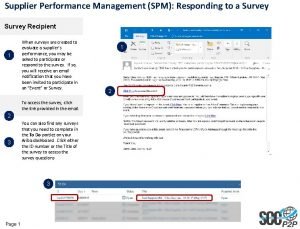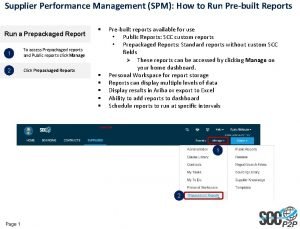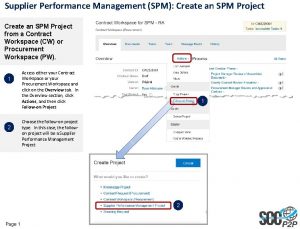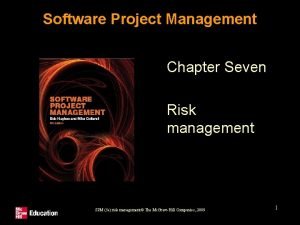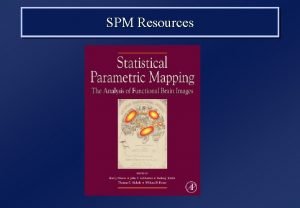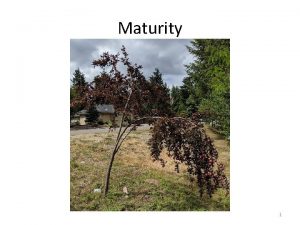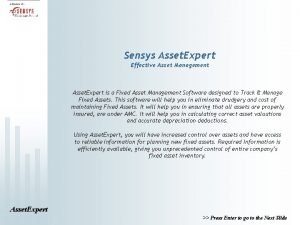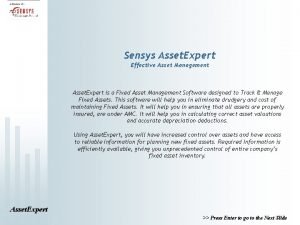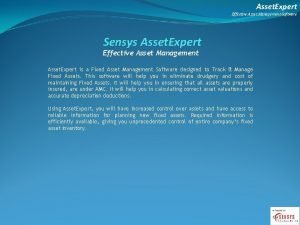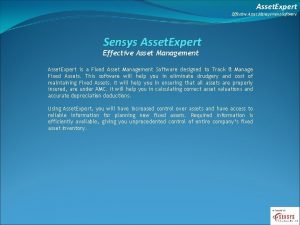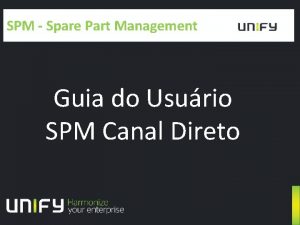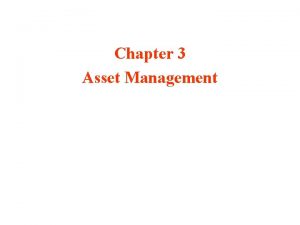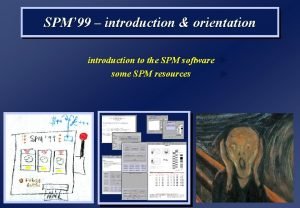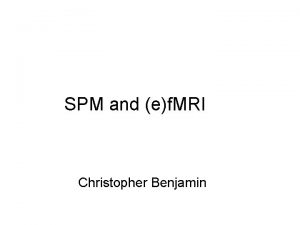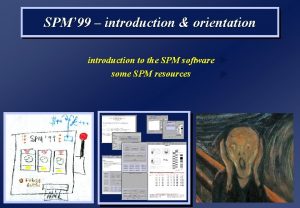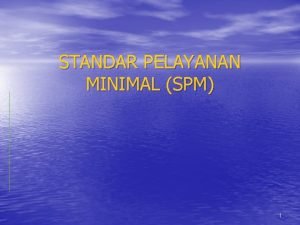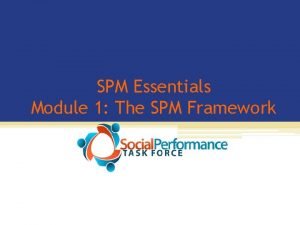Asset Management Maturity Assessment Target Setting 2016 SPM
















- Slides: 16

Asset Management Maturity Assessment Target Setting © 2016 SPM Assets Ltd Building asset intelligence

Why Targets? What do we do now? What should we use instead?

Why targets? • Consistency between – TEIs – Assessors • Comparison between – Sectors – Sub-sectors – Assessors • Understand differences • Breakdown silo assessments Consistency requires you to be as ignorant today as you were a year ago (Bernard Berenson)

“TEC is looking at ensuring consistent sector-wide meaningful performance targets to be used in the annual maturity assessments to enable more meaningful sector and subsector comparisons”

How are targets set now? • • Aware Minimum Core Intermediate Advanced 0 -20 25 -40 45 -60 65 -80 85 -100 2010 Core minimum 2013 Core 2015 Assessor set 2017 Same

What should we do instead? 1 2 3 4 5 6 7 8 9 10 11 12 13 14 15 16 17 AM Policy and Strategy Levels of Service and Performance Management Demand Forecasting Asset Register Data Asset Condition Assessment Risk Management Decision Making Operational Planning and Reporting Maintenance Planning Capital Investment Strategies Financial and Funding Strategies Asset Management Teams AM Plans Information Systems Service Delivery Models Quality Management Improvement Planning

250, 000 2015 Capital Spend 2016 Completions Capital Spend ($, 000) 20, 000 200, 000 18, 000 16, 000 150, 000 14, 000 12, 000 100, 000 10, 000 8, 000 50, 000 0 1, 800, 000 6, 000 4, 000 Capital Base (Land & Buildings) 2, 000 0 2016 EFTS 1, 600, 000 35, 000 1, 400, 000 30, 000 Value ($, 000) 1, 200, 000 1, 000 800, 000 600, 000 400, 000 25, 000 20, 000 15, 000 10, 000 200, 000 5, 000 0 0

Potential Factors • Spread of Capital – EFTS – M 2 – Base Asset Value • Cost of Ownership – – Revenue to Net Asset Facilities Burden Ratio Cashflow to CAPEX ratio Geographic spread • Change – EFTS – Capital intentions • State of Assets – – FCI Age Deferred Maintenance Performance

Factor/Section Matrix Strawman 2016 EFTS 35, 000 30, 000 25, 000 20, 000 15, 000 10, 000 5, 000 0

Strawman - input Factor Basis Total EFTs This year m 2 Base Asset $ Change in EFTs Over next 3 year period Plan Spend Over next 3 year period ODRC/ORC Latest. Same year as Base asset value Facilities Condition Index 10 -years capital intention plan submission TEI size 0 -8, 000 <100, 000 >$1, 000 M <± 10% <$10 M >0. 4 <10% Core Intermediate Advanced Core

Strawman matrix Lifecycle Asset Management Decision Enablers Making Understanding and Defining Requirements Indicator Section AM Policy and Strategy Lo. S and Performance Management Demand Forecasting Asset Condition Assessment Asset Register Data Risk Management Decision Making Operational Planning and Reporting Maintenance Planning Capital Investment Strategies Financial and Funding Strategies Asset Management Teams AM Plans Information Systems Service Delivery Models Quality Management Improvement Planning Total EFTs 10 m 2 Base Change Plan Asset $ in EFTs Spend 1

What should we use instead? • Other factors? • Impact each factor has on the 17 Sections • Is a rational split based on clustering OK or should we use ⅓: ⅓: ⅓ • Who uses the tool, TEC, Assessors, the TEI?

Other Factors • Spread of Capital – EFTS – M 2 – Base Asset Value • Cost of Ownership – – Revenue to Net Asset Facilities Burden Ratio Cashflow to CAPEX ratio Geographic spread • Change – EFTS – Capital intentions • State of Assets – – FCI Age Deferred Maintenance Performance

Impact each factor has on the 17 Sections Lifecycle Asset Management Decision Enablers Making Understanding and Defining Requirements Indicator Section AM Policy and Strategy Lo. S and Performance Management Demand Forecasting Asset Condition Assessment Asset Register Data Risk Management Decision Making Operational Planning and Reporting Maintenance Planning Capital Investment Strategies Financial and Funding Strategies Asset Management Teams AM Plans Information Systems Service Delivery Models Quality Management Improvement Planning Total EFTs 10 m 2 Base Change Plan Asset $ in EFTs Spend 1

Clustering or ⅓: ⅓: ⅓ or ? 2016 EFTS 35, 000 30, 000 25, 000 20, 000 15, 000 10, 000 5, 000 0

“I am never guided by a possible assessment of my work” – Vladimir Putin
 Software asset management maturity model
Software asset management maturity model Importance of maturity indices
Importance of maturity indices Master data management maturity assessment
Master data management maturity assessment National asset management assessment framework
National asset management assessment framework Primary target market and secondary target market
Primary target market and secondary target market Managing assets vs asset management
Managing assets vs asset management Strategic assessment in software project management
Strategic assessment in software project management Identity and access management capability maturity model
Identity and access management capability maturity model Cmm software engineering
Cmm software engineering Spiritual maturity assessment
Spiritual maturity assessment Target setting in schools
Target setting in schools Word 2016 session 2 post assessment
Word 2016 session 2 post assessment Spm supplier performance management
Spm supplier performance management Spm supplier performance management
Spm supplier performance management Spm supplier performance management
Spm supplier performance management Spm supplier performance management
Spm supplier performance management What is risk in spm
What is risk in spm
